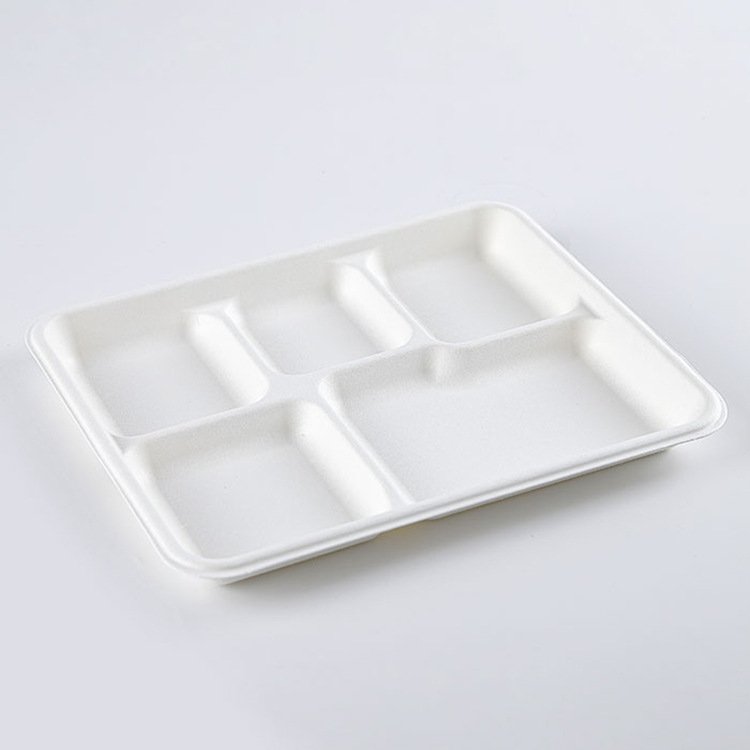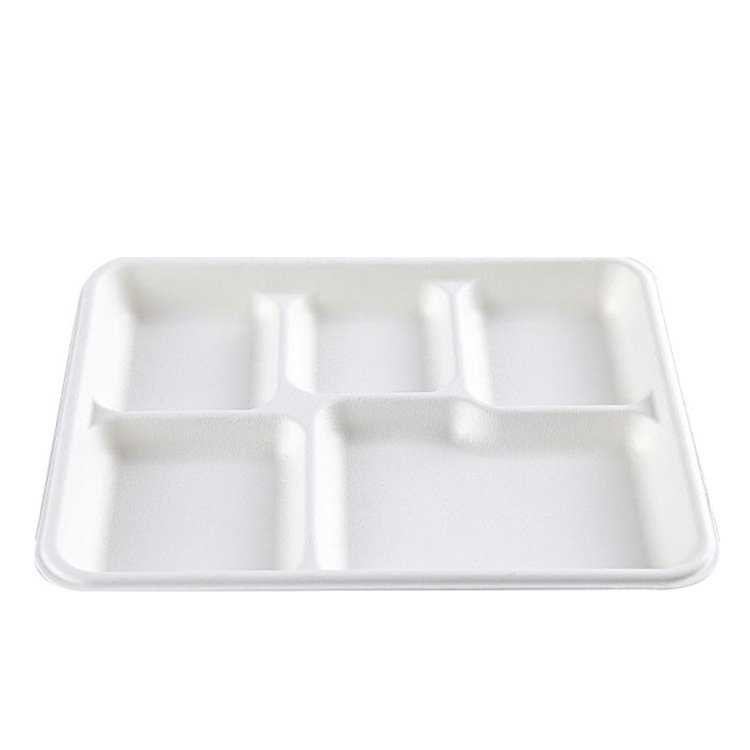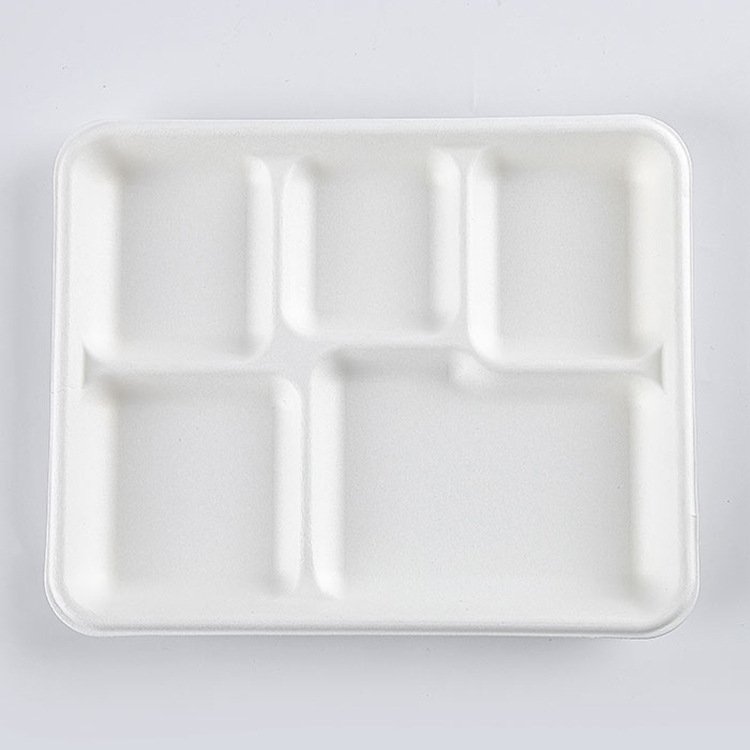Food waste is a pressing issue in schools, and it’s something that every cafeteria strives to reduce. One effective solution? The 5-compartment tray.
This simple innovation helps in controlling portions, minimizing food spillage, and encouraging students to consume all of what’s on their plates. By breaking down food into separate sections, students are more likely to focus on eating all items. Studies have shown that compartmentalized trays not only organize food better but also help to reduce waste significantly.
I’ve seen firsthand how such small changes can create lasting impacts on sustainability, particularly within the food packaging industry. As the CEO of HMZ Technology, a company that produces sustainable food packaging solutions, I’m always exploring ways to make a difference in foodservice operations. It’s clear to me that 5-compartment trays are one of the simplest yet most impactful solutions in the battle against food waste.

How Do 5-Compartment Trays Work?
The 5-compartment tray is designed with five distinct sections, allowing for different types of food to be separated. This division helps students to visualize and separate food, which in turn, helps them eat more deliberately and mindfully. For example, when they see the vegetables, fruits, grains, proteins, and dairy neatly divided, they are more inclined to try each section and finish everything.
When food is served in larger portions or all mixed together, it can overwhelm the students, leading them to waste some of it. In contrast, compartmentalized trays, like the 5-compartment disposable plates we offer, break down the meal into smaller portions, which feels more manageable and encourages consumption. For this reason, many schools have started using these trays as part of their efforts to reduce food waste.
The Psychological Effect on Students
Studies have shown that portion size plays a crucial role in food consumption behavior. When food is organized into separate compartments, students are less likely to overfill their plates or discard uneaten food. This setup taps into psychology by providing smaller portions, which appear more manageable to the students. They are more likely to finish their meal when they see clear portions.
Additionally, the visually appealing nature of the trays might subconsciously encourage students to eat all their food. By making the meal look more structured and organized, it sends a signal to students to finish the food. It also helps them track what they’ve eaten and what they still need to eat, helping reduce unnecessary food waste.
This effect is particularly beneficial in school cafeterias where time is often limited. Students are more likely to finish what they start when everything is neatly arranged on compartment food trays with lids, which helps to keep the food in place during transit.

Healthier Choices with Compartments
When food is divided into sections, it can promote healthier eating choices. Schools can take advantage of the 5-compartment tray to provide balanced meals that encourage students to try a variety of foods. This system supports a more diverse and nutritious meal selection, as each compartment can contain a different food group like fruits, vegetables, protein, grains, and dairy.
Not only does this help with portion control, but it also ensures students are exposed to healthier, well-rounded meals. Research has shown that when students are encouraged to eat different types of foods at the same time, they are more likely to consume a balanced diet. This can contribute to long-term health benefits, in addition to reducing food waste.
Practical Benefits of 5-Compartment Trays
For school cafeteria staff, 5-compartment trays make serving food more efficient. With each food item compartmentalized, it’s easier for staff to distribute meals quickly and accurately. This reduces the chance of mistakes in food portioning, preventing over-serving or under-serving students.
Moreover, 5-compartment trays are typically made from sustainable materials, which ties into the growing trend of eco-friendly initiatives in schools. As more schools prioritize sustainability, opting for eco-friendly trays, like compartment trays disposable made from biodegradable materials, that help reduce food waste is an obvious choice. For instance, at HMZ Technology, we offer sustainable options like bagasse and PLA trays, which are compostable and contribute to reducing environmental impact.
The use of compostable and biodegradable trays ensures that the trays themselves don’t add to waste, making the entire cafeteria operation more sustainable. Schools can promote a greener environment, all while actively tackling food waste.
The Role of Schools in Reducing Food Waste
The role of schools in reducing food waste is more critical than ever. As educational institutions, schools have the power to lead by example, teaching students about sustainable practices and how they can apply them in everyday life. By using 5-compartment trays, schools aren’t just tackling food waste—they are promoting sustainability on a larger scale.
Furthermore, food waste reduction in schools can have broader societal impacts. Reducing the amount of food thrown away at schools decreases the overall environmental footprint of food production, storage, and transportation. This is a significant contribution to reducing greenhouse gas emissions.
I believe that schools, through strategic choices like adopting 5-compartment disposable plates, can make a real difference in shaping the future of sustainability.

Making a Case for More Widespread Adoption
Despite the many benefits of 5-compartment trays, there’s still work to be done to make them a standard in school cafeterias everywhere. Schools may face budget constraints or resistance to change, but the evidence supporting the positive impact of these trays on food waste is compelling.
With increasing awareness of sustainability and food waste reduction, I foresee more schools adopting these trays as part of their long-term cafeteria strategies. As more students and staff experience the benefits, the demand for sustainable and efficient food packaging solutions like compartment trays with lids will continue to grow.
It’s also encouraging to see that many school districts are already taking the lead in providing students with eco-friendly, food-waste-reducing trays. The move toward sustainability in schools isn’t just a trend; it’s a responsibility that can have lasting benefits.
Conclusion
Incorporating 5-compartment trays in school cafeterias is a simple yet highly effective way to reduce food waste. These trays help manage portion sizes, encourage healthier eating, and promote sustainability. With their numerous benefits, I believe these trays have the potential to make a significant impact on food waste reduction in schools worldwide. Ultimately, it’s about small changes adding up to a bigger, more sustainable future.
What are your thoughts on 5-compartment trays? Have you seen any positive changes in your own school cafeteria?

